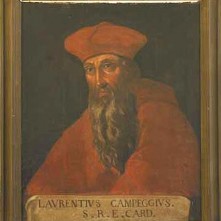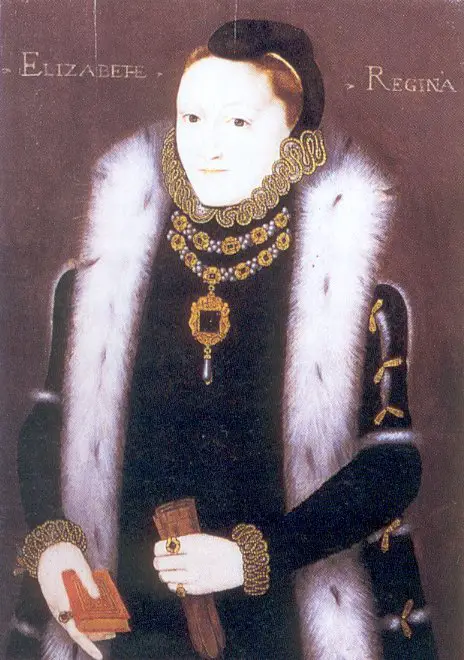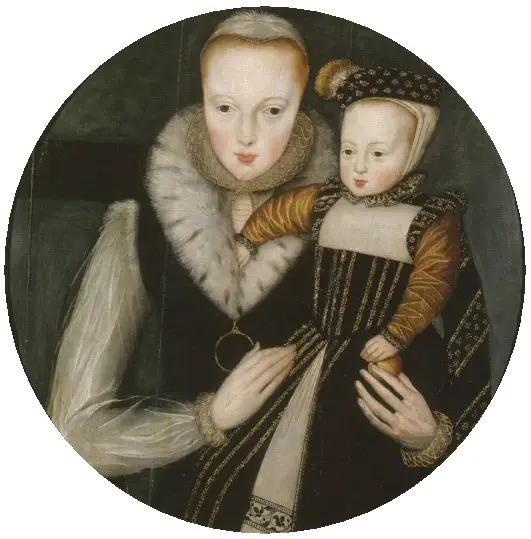28 September
1502 – Death of Robert Willoughby, 1st Baron Willoughby de Broke, at Callington, Cornwall. He was buried at Callington Church. Willoughby had been in exile in Brittany with Henry Tudor and fought with him at the Battle of Bosworth. He served Henry VII as Lord Steward and was made a Knight of the Garter in 1489.1553 - Mary I travelled in a decorated barge to the Tower of London to prepare for her coronation. She was accompanied by her half-sister, Elizabeth.
1558 (28th or 29th) – Death of Sir Robert Acton, Royal Saddler and member of Parliament. He was buried in Elmley Lovett church. Acton also served as a Justice of the Peace and Sheriff during Henry VIII's reign, as well as being on the council in the marches of Wales. As Royal Saddler, he went with the King to Boulogne in 1544.
1560 – Death of Francis Talbot, 5th Earl of Shrewsbury, at Sheffield. He was buried at St Peter's Church, Sheffield, which is now the cathedral.
1582 – Death of George Buchanan, Scottish historian, humanist scholar and poet. He was buried in Greyfriars churchyard in Edinburgh. His works included his 1579 “History of Scotland” (Rerum Scoticarum Historia), the 1579 treatise De Jure Regni apud Scotos, his satire “Chamaeleon” and his poems.
1594 – Death of John Piers, Archbishop of York, at his home, Bishopthorpe. He was aged seventy-one. Piers was buried at York Minster.
1599 – Robert Devereux, 2nd Earl of Essex, strode into Elizabeth I's bedchamber unannounced and saw the Queen without her makeup or wig, without her “mask of youth”.
29 September
1528 – The papal legate, Cardinal Lorenzo Campeggio, landed at Dover on the Kent coast. He had arrived in preparation for hearing the case for the annulment of the marriage of Henry VIII and Catherine of Aragon at a special legatine court.1553 – Mary I created fifteen Knights of the Bath as part of her coronation celebrations.
1558 – Death of George Brooke, 9th Baron Cobham, soldier and landowner. He was buried at Cobham Church. Cobham acted as Lieutenant-General in spring 1544 when English forces invaded Scotland, and was made Deputy of Calais in June 1544. He was created a Knight of the Garter in 1549, and was on Edward VI's Privy Council. He was imprisoned in the Tower of London temporarily in 1554 after being implicated in Wyatt's Rebellion, but was released and fined.
1564 - Robert Dudley was made Earl of Leicester, an earldom which had been planned earlier in the year to make him more acceptable as a bridegroom to Mary, Queen of Scots.
30 September
1515 – Margaret Tudor, sister of Henry VIII and former Queen Consort of James IV, fled to England. Margaret was pregnant with the child of her new husband, Archibald Douglas, 6th Earl of Angus. John Stewart, 2nd Earl of Albany, was acting as Regent for Margaret's son, the young James V, and had custody of the boy and his brother, Alexander.1544 – Henry VIII returned to England after his victory in Boulogne. The French forces had surrendered on 13th September after a siege which lasted from 19th July.
1546 – Death of Sir Richard Long, member of Parliament and gentleman of Henry VIII's privy chamber.
1553 - Mary I's coronation procession from the Tower of London to Whitehall.
1585 – Philip Howard, Earl of Arundel and son of Thomas Howard, 4th Duke of Norfolk, was received into the Catholic Church by Jesuit William Weston at Arundel Castle.
1 October
1500 – Death of John Alc*ck, Bishop of Ely, scholar and Royal Tutor, at Wisbech Castle. He was buried at Ely Cathedral, in the chantry chapel he had designed. Alc*ck had acted as tutor to Prince Edward, son of Edward IV, and had also been president of the Prince's Council at Ludlow. He was also Henry VII's first Chancellor and opened his first Parliament.
1505 – Death of Sir Henry Colet, merchant and Lord Mayor of London, at Stepney. He was buried there.
1526 – Birth of Dorothy Stafford, Lady Stafford, daughter of Henry Stafford, 10th Baron Stafford, and his wife, Ursula (née Pole). Dorothy married Sir William Stafford, widower of Mary Boleyn, in 1545. She served Elizabeth I as a gentlewoman of the Privy Chamber.
1553 - Mary I was crowned Queen at Westminster Abbey by Stephen Gardiner, the Bishop of Winchester.
2 October
1452 - Richard III, the last Plantagenet king, was born at Fotheringhay Castle, Northamptonshire. Richard was the youngest surviving child of Richard, 3rd Duke of York, and Cecily Neville. Richard claimed the English throne in June 1483, claiming that his brother Edward IV’s sons were illegitimate because Edward had been pre-contracted to another woman when he married Elizabeth Woodville. Richard III was killed at the Battle of Bosworth on 22nd August 1485, and Henry Tudor claimed the throne as Henry VII.1501 – Catherine of Aragon arrived in England, landing at Plymouth in Devon. She had come to England to marry Prince Arthur, the heir to the throne of England.
1514 – Mary Tudor, sister of Henry VIII, set off from Dover to sail to France to marry King Louis XII. She was eighteen and he was fifty-two, and not in the best of health. They married on 9th October 1514, but the marriage was short-lived as Louis died in January 1515. Mary went on to marry Charles Brandon, the Duke of Suffolk, on the 3rd March 1515.
1518 – Treaty of London – Cardinal Wolsey’s treaty of “Universal” peace between France and England was signed.
1521 – Pope Leo X was given Henry VIII’s Assertio septem sacramentorum or “Defence of the Seven Sacraments” in Rome. This work led to Henry VIII being proclaimed Fidei Defensor or “Defender of the Faith”.
1528 – Publication of William Tyndale’s “The Obedience of the Christian Man and How Christian Rulers Ought to Govern”.
1536 – Start of the Lincolnshire Rising, the beginning of the Pilgrimage of Grace. It was sparked off by a sermon at evensong on the 1st October at St James’s Church, Louth, and by a visitation from a registrar on 2nd October.
3 October
1518 - Cardinal Wolsey sang a mass to Henry VIII and the French ambassadors at St Paul's Cathedral in celebration of the treaty agreed between the two countries the previous day. The King and ambassadors also took oaths to the treaty.
1559 – Death of Sir William Fitzwilliam, Gentleman of Edward VI's Privy Chamber. He was buried in St George's Chapel, Windsor Castle.
1584 – Death of Sir Gilbert Dethick, herald, Garter Principal King of Arms and diplomat, in London. He was laid to rest in the church of St Benet Paul's Wharf. Dethick's offices included Hampnes Pursuivant of Arms Extraordinary (1536), Rouge Croix Pursuivant of Arms in Ordinary (1540), Richmond Herald of Arms in Ordinary (1540), Norroy King of Arms (1547) and Garter Principal King of Arms (1550).
4 October
1507 – Birth of Sir Francis Bigod, leader of Bigod's Rebellion, at Seaton, Hinderwell, Yorkshire. Bigod led an uprising in Beverley, Yorkshire, in January 1537, following the Pilgrimage of Grace, and was executed in June 1537.1531 – Baptism of Henry Stanley, 4th Earl of Derby, at Lathom House, Lancashire. He was the eldest son of Edward Stanley, 3rd Earl of Derby, and his wife, Dorothy (née Howard). Derby served Elizabeth I as an Ambassador, Privy Councillor and Lord High Steward at the trial of Philip Howard, Earl of Arundel and Surrey.
1536 - There was trouble in Horncastle, Lincolnshire. This was part of what we know as the Lincolnshire Rising which, in turn, was part of the Pilgrimage of Grace rebellion. Dr Raynes, the chancellor of the Bishop of Lincoln, was killed by the rebels, as was Thomas Wulcey (or Wolsey), one of Cromwell’s men.
1539 – Signing of the marriage treaty between Henry VIII and Anne of Cleves.
1556 – John Cheke made a public recantation of his Protestant faith in front of Queen Mary I.
1581 – Death of Henry Wriothesley, 2nd Earl of Southampton, at Itchel in Hampshire. He was buried at Titchfield.








Leave a Reply